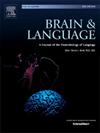Delineating Region-Specific contributions and connectivity patterns for semantic association and categorization through ROI and Granger causality analysis
IF 2.3
2区 心理学
Q1 AUDIOLOGY & SPEECH-LANGUAGE PATHOLOGY
引用次数: 0
Abstract
The neural mechanisms supporting semantic association and categorization are examined in this study. Semantic association involves linking concepts through shared themes, events, or scenes, while semantic categorization organizes meanings hierarchically based on defining features. Twenty-three adults participated in an fMRI study performing categorization and association judgment tasks. Results showed stronger activation in the inferior frontal gyrus during association and marginally weaker activation in the posterior middle temporal gyrus (pMTG) during categorization. Granger causality analysis revealed bottom-up connectivity from the visual cortex to the hippocampus during semantic association, whereas semantic categorization exhibited strong reciprocal connections between the pMTG and frontal semantic control regions, together with information flow from the visual association area and hippocampus to the pars triangularis. We propose that demands on semantic retrieval, precision of semantic representation, perceptual experiences and world knowledge result in observable differences between these two semantic relations.
通过 ROI 和格兰杰因果关系分析,为语义关联和分类划分特定区域贡献和连接模式
本研究探讨了支持语义联想和分类的神经机制。语义联想是指通过共同的主题、事件或场景将概念联系起来,而语义分类则是根据定义特征对意义进行分级组织。23 名成年人参加了一项 fMRI 研究,执行分类和联想判断任务。结果显示,在联想过程中,额叶下回的激活较强,而在分类过程中,颞叶后中回(pMTG)的激活稍弱。格兰杰因果关系分析表明,在语义联想过程中,视觉皮层与海马之间存在自下而上的联系,而语义分类过程中,pMTG与额叶语义控制区之间存在很强的互惠联系,同时,信息流也从视觉联想区和海马流向三角旁。我们认为,对语义检索的要求、语义表征的精确性、知觉经验和世界知识导致了这两种语义关系之间可观察到的差异。
本文章由计算机程序翻译,如有差异,请以英文原文为准。
求助全文
约1分钟内获得全文
求助全文
来源期刊

Brain and Language
医学-神经科学
CiteScore
4.50
自引率
8.00%
发文量
82
审稿时长
20.5 weeks
期刊介绍:
An interdisciplinary journal, Brain and Language publishes articles that elucidate the complex relationships among language, brain, and behavior. The journal covers the large variety of modern techniques in cognitive neuroscience, including functional and structural brain imaging, electrophysiology, cellular and molecular neurobiology, genetics, lesion-based approaches, and computational modeling. All articles must relate to human language and be relevant to the understanding of its neurobiological and neurocognitive bases. Published articles in the journal are expected to have significant theoretical novelty and/or practical implications, and use perspectives and methods from psychology, linguistics, and neuroscience along with brain data and brain measures.
 求助内容:
求助内容: 应助结果提醒方式:
应助结果提醒方式:


